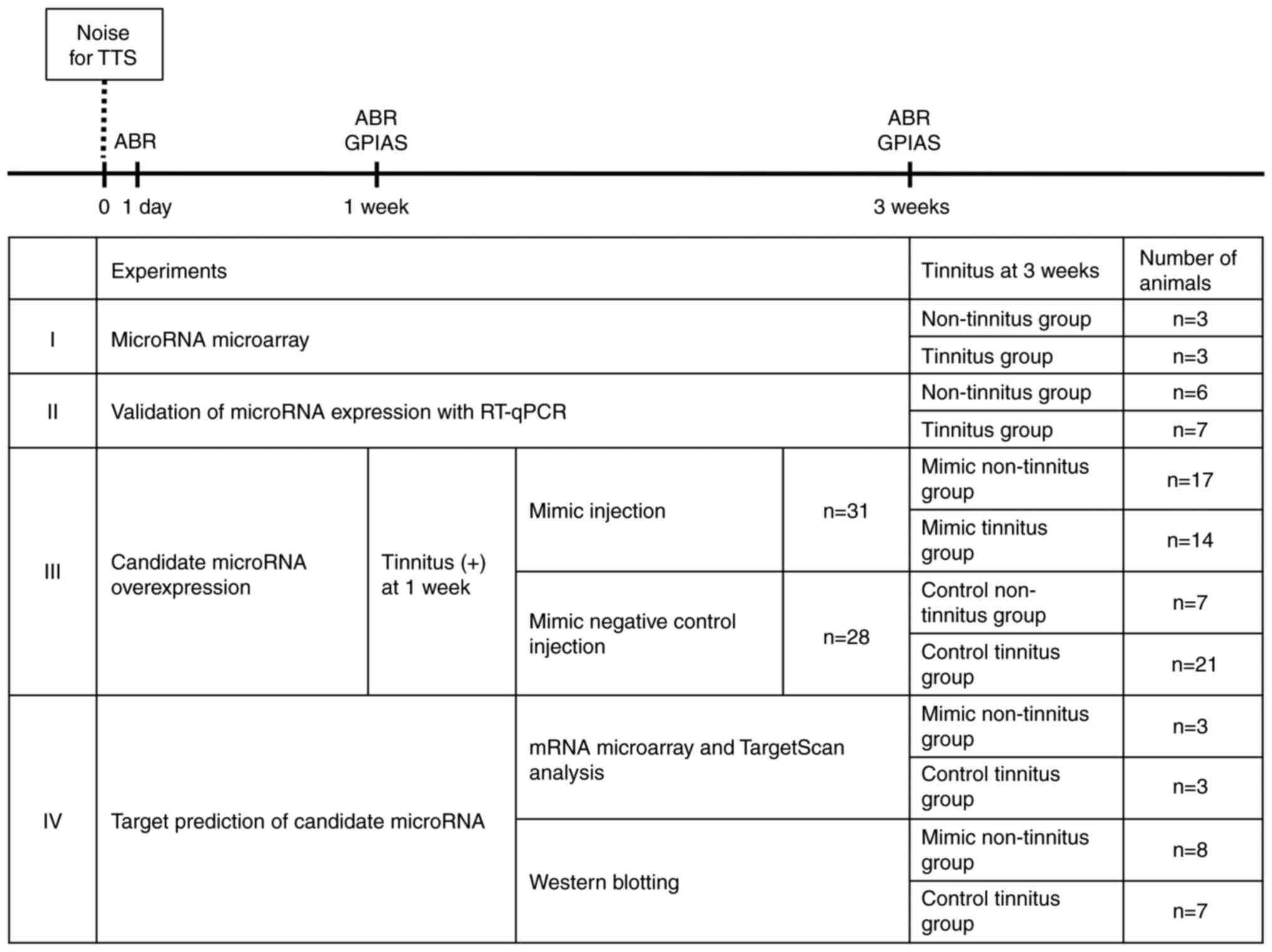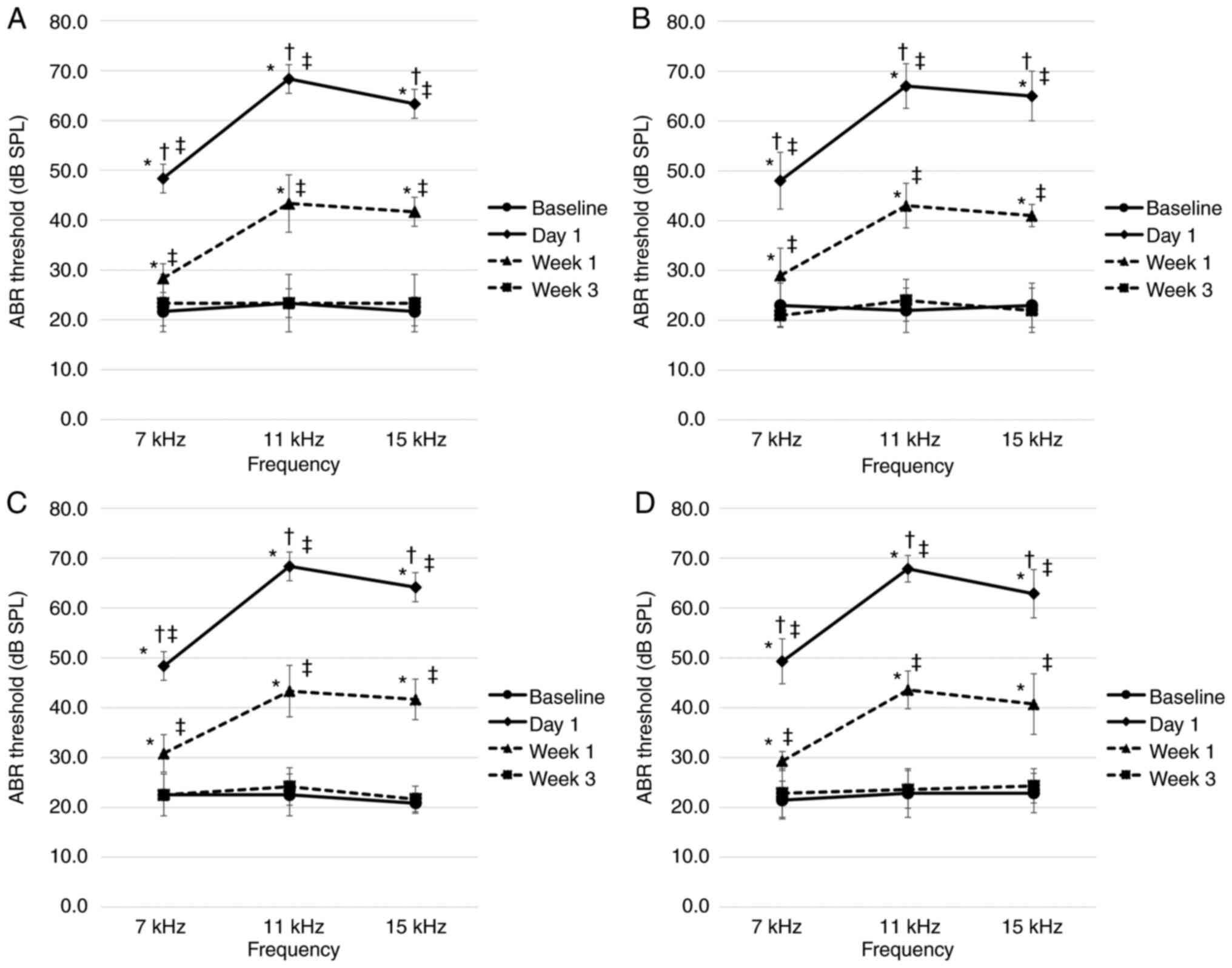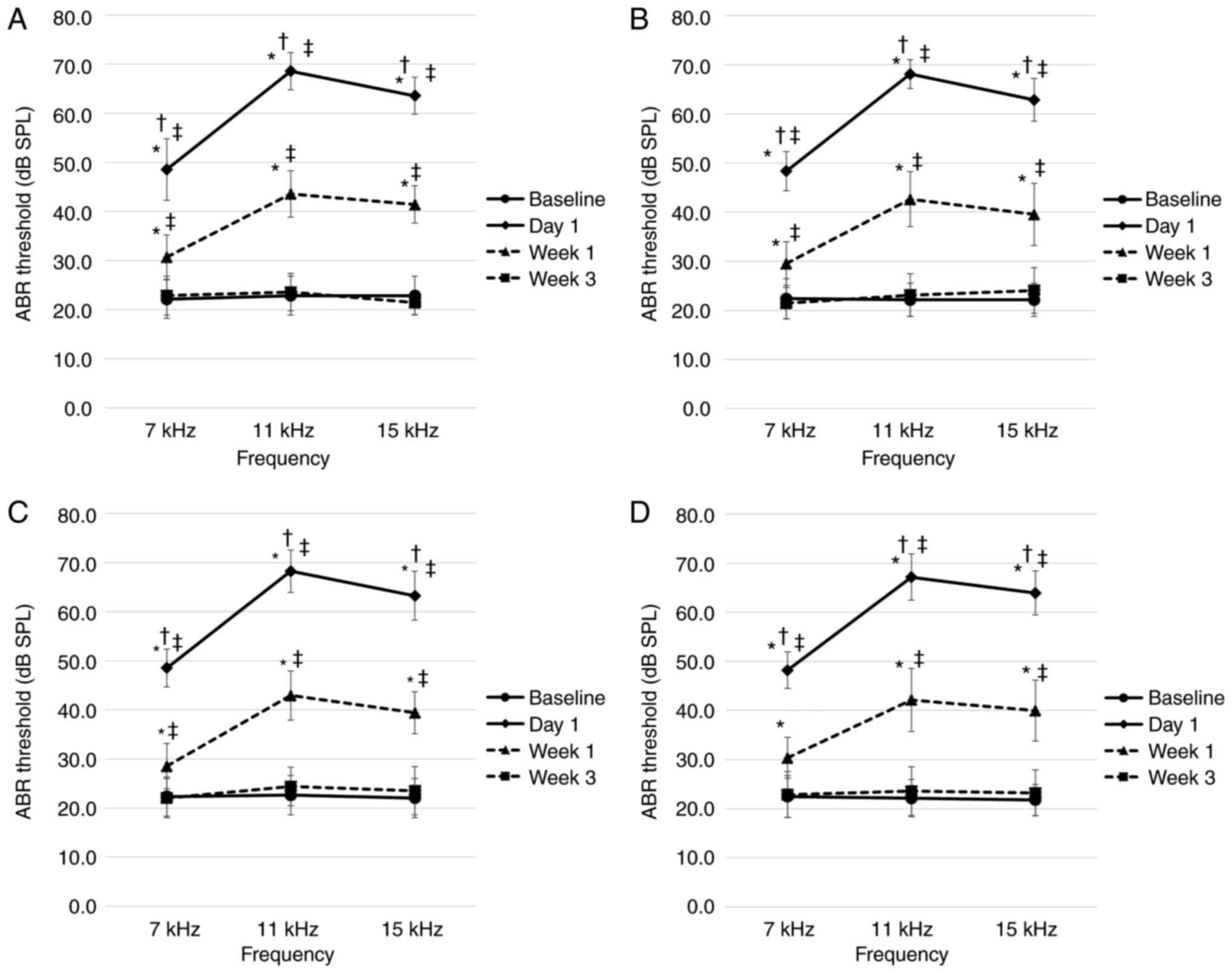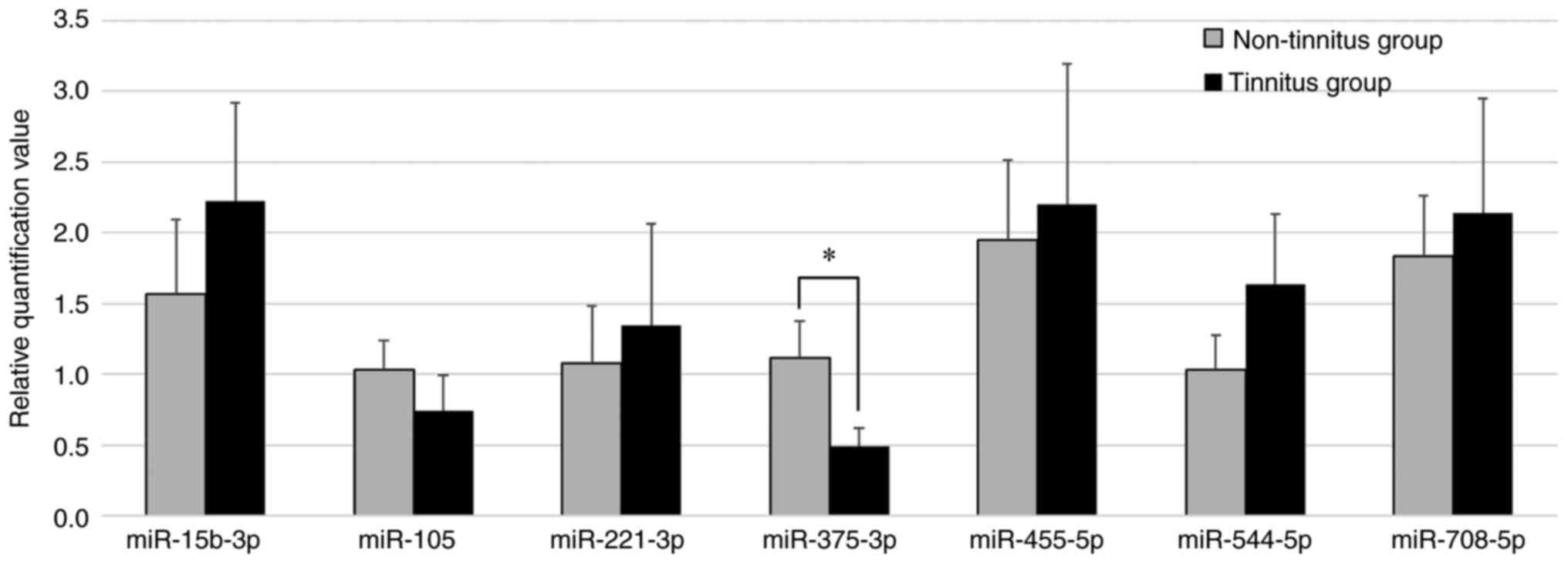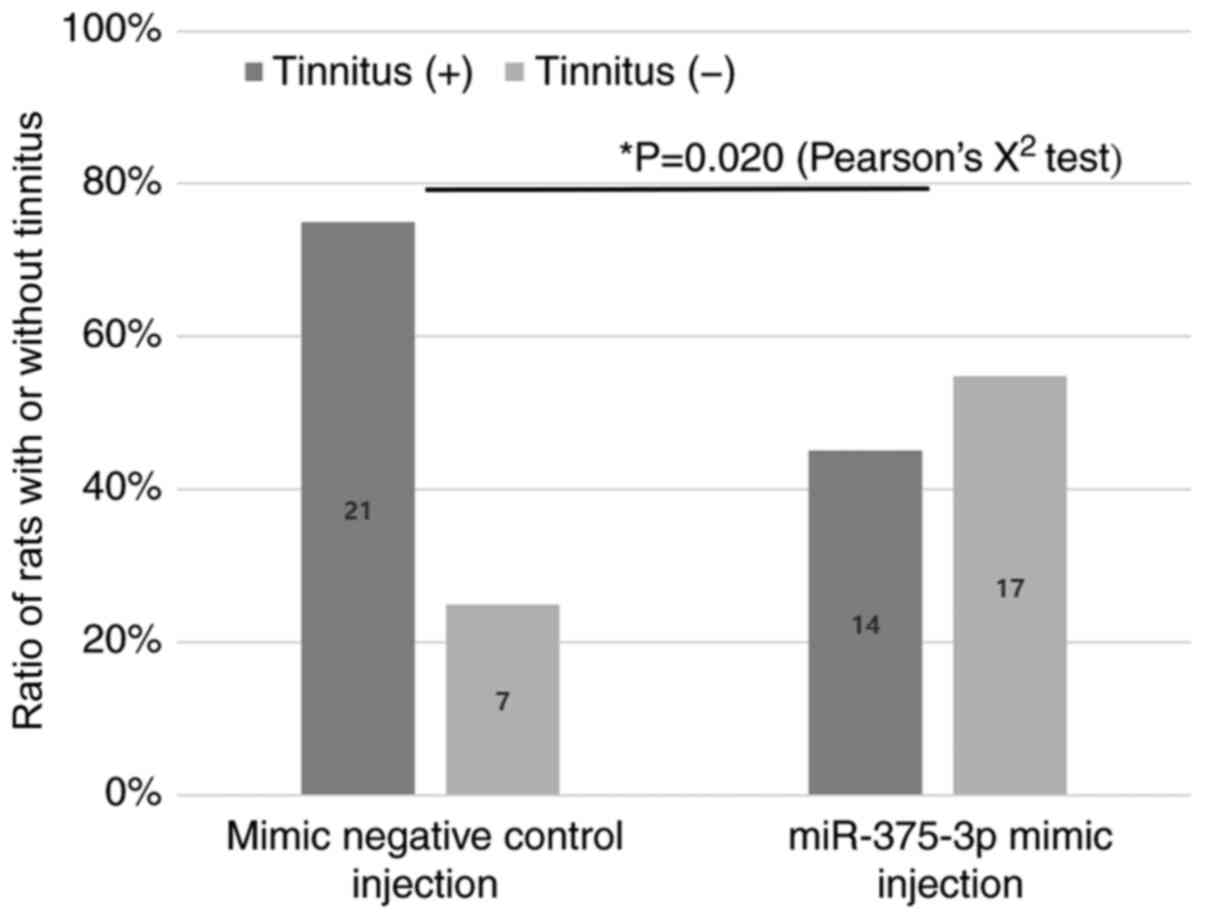|
1
|
Axelsson A and Ringdahl A: Tinnitus-a
study of its prevalence and characteristics. Br J Audiol. 23:53–62.
1989. View Article : Google Scholar : PubMed/NCBI
|
|
2
|
Hébert S, Canlon B and Hasson D: Emotional
exhaustion as a predictor of tinnitus. Psychother Psychosom.
81:324–326. 2012. View Article : Google Scholar : PubMed/NCBI
|
|
3
|
Langguth B: A review of tinnitus symptoms
beyond 'ringing in the ears': A call to action. Curr Med Res Opin.
27:1635–1643. 2011. View Article : Google Scholar : PubMed/NCBI
|
|
4
|
Shargorodsky J, Curhan GC and Farwell WR:
Prevalence and characteristics of tinnitus among US adults. Am J
Med. 123:711–718. 2010. View Article : Google Scholar : PubMed/NCBI
|
|
5
|
Jastreboff PJ: Tinnitus retraining
therapy. Prog Brain Res. 166:415–423. 2007. View Article : Google Scholar : PubMed/NCBI
|
|
6
|
Moller AR: Tinnitus: Presence and future.
Prog Brain Res. 166:3–16. 2007. View Article : Google Scholar : PubMed/NCBI
|
|
7
|
Cima RFF, Mazurek B, Haider H, Kikidis D,
Lapira A, Norena A and Hoare DJ: A multidisciplinary European
guideline for tinnitus: Diagnostics, assessment, and treatment.
HNO. 67(Suppl 1): S10–S42. 2019. View Article : Google Scholar
|
|
8
|
Tunkel DE, Bauer CA, Sun GH, Rosenfeld RM,
Chandrasekhar SS, Cunningham ER Jr, Archer SM, Blakley BW, Carter
JM, Granieri EC, et al: Clinical practice guideline: Tinnitus.
Otolaryngol Head Neck Surg. 151(Suppl 2): S1–S40. 2014. View Article : Google Scholar : PubMed/NCBI
|
|
9
|
Dehmel S, Pradhan S, Koehler S, Bledsoe S
and Shore S: Noise overexposure alters long-term
somatosensory-auditory processing in the dorsal cochlear
nucleus-possible basis for tinnitus-related hyperactivity? J
Neurosci. 32:1660–1671. 2012. View Article : Google Scholar : PubMed/NCBI
|
|
10
|
Koehler SD and Shore SE: Stimulus
timing-dependent plasticity in dorsal cochlear nucleus is altered
in tinnitus. J Neurosci. 33:19647–19656. 2013. View Article : Google Scholar : PubMed/NCBI
|
|
11
|
Zeng C, Yang Z, Shreve L, Bledsoe S and
Shore S: Somatosensory projections to cochlear nucleus are
upregulated after unilateral deafness. J Neurosci. 32:15791–15801.
2012. View Article : Google Scholar : PubMed/NCBI
|
|
12
|
Han KH, Mun SK, Sohn S, Piao XY, Park I
and Chang M: Axonal sprouting in the dorsal cochlear nucleus
affects gap-prepulse inhibition following noise exposure. Int J Mol
Med. 44:1473–1483. 2019.PubMed/NCBI
|
|
13
|
Hollins SL and Cairns MJ: MicroRNA: Small
RNA mediators of the brains genomic response to environmental
stress. Prog Neurobiol. 143:61–81. 2016. View Article : Google Scholar : PubMed/NCBI
|
|
14
|
Campbell K and Booth SA: MicroRNA in
neurodegenerative drug discovery: The way forward? Expert Opin Drug
Discov. 10:9–16. 2015. View Article : Google Scholar
|
|
15
|
Esteller M: Non-coding RNAs in human
disease. Nat Rev Genet. 12:861–874. 2011. View Article : Google Scholar : PubMed/NCBI
|
|
16
|
Gebert LF, Rebhan MA, Crivelli SE, Denzler
R, Stoffel M and Hall J: Miravirsen (SPC3649) can inhibit the
biogenesis of miR-122. Nucleic Acids Res. 42:609–621. 2014.
View Article : Google Scholar
|
|
17
|
National Research Council: Guide for the
Care and Use of Laboratory Animals. The National Academies Press
Inc; Washington, DC: 2011
|
|
18
|
Paxinos G and Watson C: The Rat Brain in
Stereotaxic Coordinates. Academic Press Inc; Burlington, MA:
2006
|
|
19
|
Mun SK, Han KH, Baek JT, Ahn SW, Cho HS
and Chang MY: Losartan prevents maladaptive Auditory-Somatosensory
plasticity after hearing loss via transforming growth Factor-β
signaling suppression. Clin Exp Otorhinolaryngol. 12:33–39. 2019.
View Article : Google Scholar
|
|
20
|
Longenecker RJ and Galazyuk AV:
Methodological optimization of tinnitus assessment using prepulse
inhibition of the acoustic startle reflex. Brain Res. 1485:54–62.
2012. View Article : Google Scholar : PubMed/NCBI
|
|
21
|
Chang MY, Park S, Choi JJ, Kim YK, Suh MW,
Lee JH, Oh SH and Park MK: MicroRNAs 218a-5p, 219a-5p, and 221-3p
regulate vestibular compensation. Sci Rep. 7:87012017. View Article : Google Scholar : PubMed/NCBI
|
|
22
|
Livak KJ and Schmittgen TD: Analysis of
relative gene expressio. data using real-time quantitative PCR and
the 2(-Delta Delta C(T)). Method Methods. 25:402–408. 2001.
View Article : Google Scholar
|
|
23
|
Ou J, Kou L, Liang L and Tang C: MiR-375
attenuates injury of cerebral ischemia/reperfusion via targetting
Ctgf. Biosci Rep. 37:BSR201712422017. View Article : Google Scholar
|
|
24
|
Dugas JC, Cuellar TL, Scholze A, Ason B,
Ibrahim A, Emery B, Zamanian JL, Foo LC, McManus MT and Barres BA:
Dicer1 and miR-219 Are required for normal oligodendrocyte
differentiation and myelination. Neuron. 65:597–611. 2010.
View Article : Google Scholar : PubMed/NCBI
|
|
25
|
Giraldez AJ, Cinalli RM, Glasner ME,
Enright AJ, Thomson JM, Baskerville S, Hammond SM, Bartel DP and
Schier AF: MicroRNAs regulate brain morphogenesis in zebrafish.
Science. 308:833–838. 2005. View Article : Google Scholar : PubMed/NCBI
|
|
26
|
Schratt GM, Tuebing F, Nigh EA, Kane CG,
Sabatini ME, Kiebler M and Greenberg ME: A brain-specific microRNA
regulates dendritic spine development. Nature. 439:283–289. 2006.
View Article : Google Scholar : PubMed/NCBI
|
|
27
|
Banerjee-Basu S, Larsen E and Muend S:
Common microRNAs target established ASD genes. Front Neurol.
5:2052014. View Article : Google Scholar : PubMed/NCBI
|
|
28
|
Im HI and Kenny PJ: MicroRNAs in neuronal
function and dysfunction. Trends Neurosci. 35:325–334. 2012.
View Article : Google Scholar : PubMed/NCBI
|
|
29
|
Sun E and Shi Y: MicroRNAs: Small
molecules with big roles in neurodevelopment and diseases. Exp
Neurol. 268:46–53. 2015. View Article : Google Scholar
|
|
30
|
Ding L, Xu Y, Zhang W, Deng Y, Si M, Du Y,
Yao H, Liu X, Ke Y, Si J and Zhou T: MiR-375 frequently
downregulated in gastric cancer inhibits cell proliferation by
targeting JAK2. Cell Res. 20:784–793. 2010. View Article : Google Scholar : PubMed/NCBI
|
|
31
|
He XX, Chang Y, Meng FY, Wang MY, Xie QH,
Tang F, Li PY, Song YH and Lin JS: MicroRNA-375 targets AEG-1 in
hepatocellular carcinoma and suppresses liver cancer cell growth in
vitro and in vivo. Oncogene. 31:3357–3369. 2012. View Article : Google Scholar
|
|
32
|
Kapsimali M, Kloosterman WP, de Bruijn E,
Rosa F, Plasterk RH and Wilson SW: MicroRNAs show a wide diversity
of expression profiles in the developing and mature central nervous
system. Genome Biol. 8:R1732007. View Article : Google Scholar : PubMed/NCBI
|
|
33
|
Bhinge A, Namboori SC, Bithell A, Soldati
C, Buckley NJ and Stanton LW: MiR-375 is essential for human spinal
motor neuron development and may be involved in motor neuron
degeneration. Stem Cells. 34:124–134. 2016. View Article : Google Scholar
|
|
34
|
Wang C, Pan Y, Cheng B, Chen J and Bai B:
Identification of conserved and novel microRNAs in cerebral
ischemia-reperfusion injury of rat using deep sequencing. J Mol
Neurosci. 54:671–683. 2014. View Article : Google Scholar : PubMed/NCBI
|
|
35
|
Wang Y, Dong X, Li Z, Wang W, Tian J and
Chen J: Downregulated RASD1 and upregulated miR-375 are involved in
protective effects of calycosin on cerebral ischemia/reperfusion
rats. J Neurol Sci. 339:144–148. 2014. View Article : Google Scholar : PubMed/NCBI
|
|
36
|
Hertel M, Tretter Y, Alzheimer C and
Werner S: Connective tissue growth factor: A novel player in tissue
reorganization after brain injury? Eur J Neurosci. 12:376–380.
2000. View Article : Google Scholar : PubMed/NCBI
|
|
37
|
Hall-Glenn F and Lyons KM: Roles for CCN2
in normal physiological processes. Cell Mol Life Sci. 68:3209–3217.
2011. View Article : Google Scholar : PubMed/NCBI
|
|
38
|
Khodosevich K, Lazarini F, von Engelhardt
J, Kaneko H, Lledo PM and Monyer H: Connective tissue growth factor
regulates interneuron survival and information processing in the
olfactory bulb. Neuron. 79:1136–1151. 2013. View Article : Google Scholar : PubMed/NCBI
|
|
39
|
Bharadwaj HM, Masud S, Mehraei G, Verhulst
S and Shinn-Cunningham BG: Individual differences reveal correlates
of hidden hearing deficits. J Neurosci. 35:2161–2172. 2015.
View Article : Google Scholar : PubMed/NCBI
|
|
40
|
Elgoyhen AB, Langguth B, De Ridder D and
Vanneste S: Tinnitus: Perspectives from human neuroimaging. Nat Rev
Neurosci. 16:632–642. 2015. View Article : Google Scholar : PubMed/NCBI
|
|
41
|
Becker JB, Prendergast BJ and Liang JW:
Female rats are not more variable than male rats: A meta-analysis
of neuroscience studies. Biol Sex Differ. 7:342016. View Article : Google Scholar : PubMed/NCBI
|
|
42
|
Itoh Y and Arnold AP: Are females more
variable than males in gene expression? Meta-analysis of microarray
datasets. Biol Sex Differ. 6:182015. View Article : Google Scholar : PubMed/NCBI
|
|
43
|
Lauer AM and Schrode KM: Sex bias in basic
and preclinical noise-induced hearing loss research. Noise Health.
19:207–212. 2017. View Article : Google Scholar : PubMed/NCBI
|















